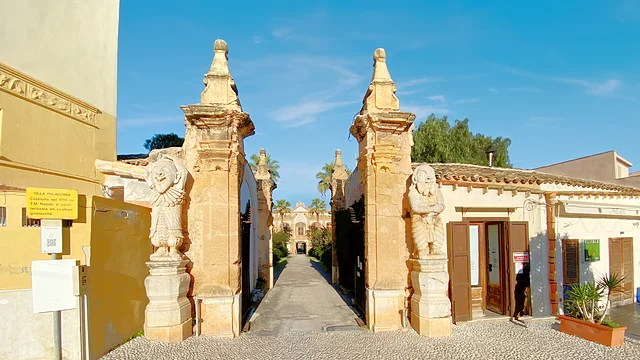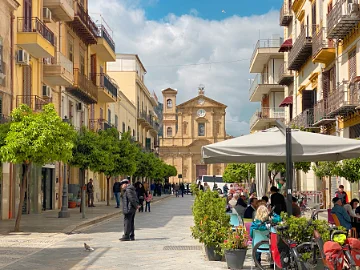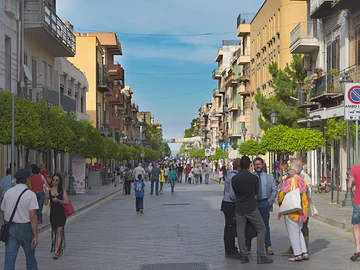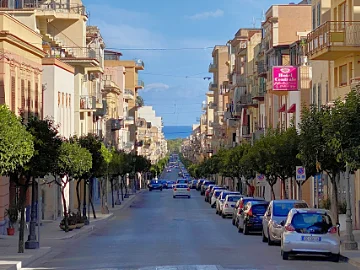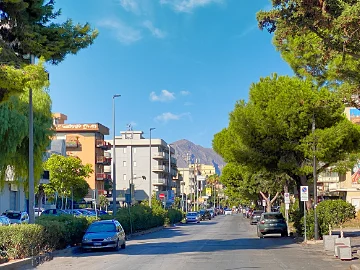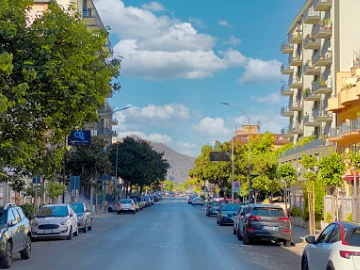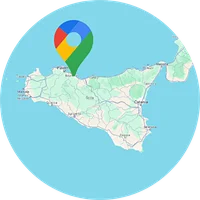Old town - Things to see and do
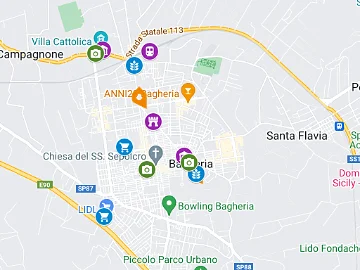
Bagheria map
The map (Google Maps) of the old town of Bagheria offers you an overview of some things to see, its shopping facilities and the exact location of the Solemar Sicilia holiday lettings.
Below you will find a list of all Sicily - All in one Place maps.
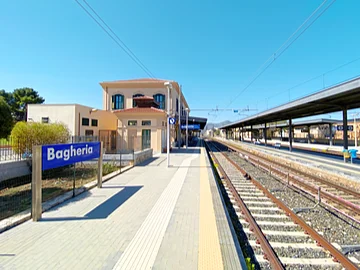
Station
Yes - Bagheria is Palermo's little sister. You can find almost everything here that you can find there. But the big sister has a few unique sides.
It's a good thing that Trenitalia connects both cities so well and that the railway station in Bagheria is in the old town centre.
But it is also interesting in the opposite direction. Here the Trenitalia will take you to Cefalù in 1 hour.
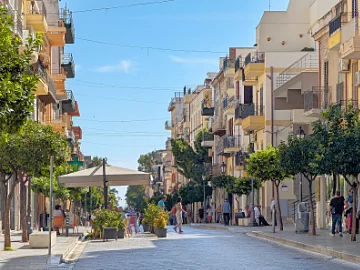
Pedestrian zone / Corso Umberto I
4 p.m. in Bagheria. The lunch break is coming to an end. The bollards at the beginning of Corso Umberto I rise, as do the roller shutters of the shops. The seats outside the bars are filling up.
At the same time, calm returns: The bollards have turned Corso Umberto I into a pedestrian zone. After closing time at 8:30 p.m., they will be lowered back into the ground again.
Why not simply close Corso Umberto I to cars completely? The answer can be found by taking a look at the narrow streets of the old town. They were created at a time when the Sicilian cart (Wikipedia) was the usual means of transport.
The good news comes at the end: on Saturdays and Sundays, Corso Umberto is a pedestrian zone from 8:00 a.m. to 9:00 p.m.
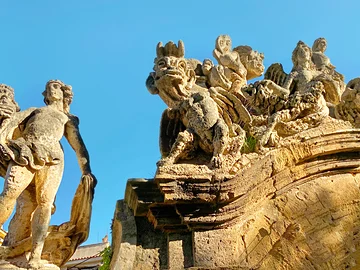
Villa Palagonia
It is Monday, 9 April 1787, and Goethe walks through the huge gate of Villa Palagonia. Ahead of him lies a 500 metre long path through fields and gardens.
Goethe, however, is less than enthusiastic. Instead of greenery, he only sees walls to the right and left on which grotesque statues are up to mischief. 500 grotesque metres long!
It doesn't get any better once he reached the castle. Project Gutenberg has published (obviously in German) Goethe's impressions on this website.
Fortunately, the gate and castle of Villa Palagonia have been preserved and can be visited. They are located in the centre of today's old town of Bagheria. So you can see for yourself. Was Goethe right?
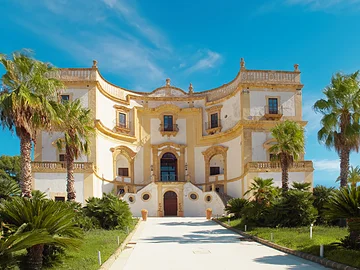
Villa Cattolica / Museo Guttuso
It all started so well: in 1736, Francesco Bonanno - the Prince of Cattolica Eraclea - bought a farmstead in Bagheria and remodelled it into a wonderful summer residence, the Villa Cattolica.
But just 30 years later, the family fell into irrecoverable debt - because of a dowry!
Villa Cattolica was sold and fell on hard times. It served as a military hospital, barracks and tinning factory, among other things.
Until 1973, when the municipality of Bagheria took over the building to exhibit works of art by the town's most famous son, Renato Guttuso (Wikipedia). These and the works of other Sicilian artists can be seen here today:
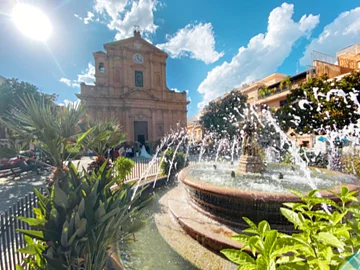
Piazza Vittorio Emanuele III
It is a sunny Saturday afternoon in Bagheria. There is excitement in the air at Piazza Vittorio Emanuele III. More and more strikingly well-dressed people gather in front of Bagheria's central church, the Chiesa Madre (Wikipedia).
And then the reason for the commotion appears - a young woman in a flowing wedding dress.
Slowly but surely, the Chiesa Madre absorbs the wedding party and calm returns to Piazza Madrice, as it is called by the locals.
A shady bench overlooking the fountain invites you to take a short break.
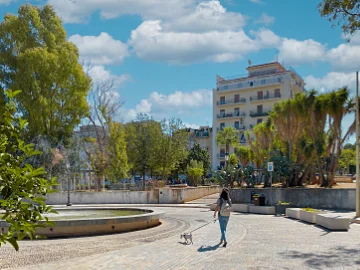
Piazza Garibaldi
Your head is spinning a little from the exciting tour of Villa Palagonia. You are standing at the exit of the villa and are therefore looking for a little relaxation.
You quickly notice the large fountain opposite. And aren't there a few tables there? Next to a small bar? That's perfect!
When you place your order, the barista tells you that you are sitting in Piazza Garibaldi. A few years ago, the piazza was still a large roundabout full of cars. There was even a petrol station here. And indeed, the roundabout and petrol station can still be seen in some Google Street View images.
Yes, Bagheria is still passionate about cars, but it is slowly beginning to appreciate limited traffic zones. This naturally includes the "part-time" pedestrian zone just around the corner.
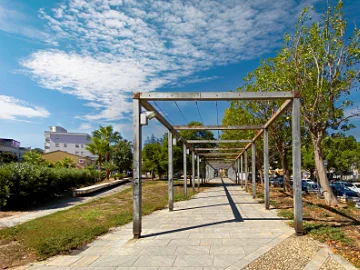
Piazza Vittime della Mafia
When paying at the bar in Piazza Garibaldi, the barista points out a square right next door - Piazza Vittime della Mafia.
Without this tip, you would have been unlikely to find this piazza. There isn't even a sign pointing to it, and it can't be found on Google Maps either.
No wonder: unlike "normal" squares, Piazza Vittime della Mafia is not located in the middle of the hustle and bustle, but in a quiet, green corner with a few benches.
Only Sunday mornings are quite busy there. That's when older gentlemen meet in the piazza to play cards.
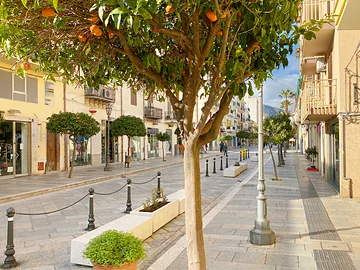
Winter
Don't worry - there's no snow in Bagheria in winter. But in return, during the "darkest season" there is an average of 4 hours of sunshine per day - and in the pedestrian zone, oranges on the trees and tables outside the bars.
For visitors from Northern Europe, what locals call "bad weather" feels more like spring.
And if the weather is really bad, Villa Palagonia and Villa Cattolica are perfect places to visit.
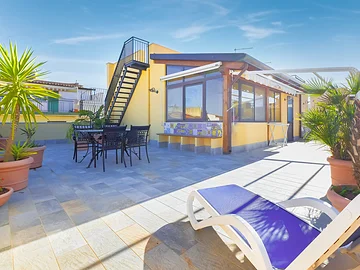
Holiday lettings
Sights such as Villa Palagonia make the old town of Bagheria very attractive for excursions.
However, many holidaymakers prefer to sleep in the old town of Santa Flavia. It is much quieter and is in a "strategically" favourable location.
As this map (Google Maps) shows, from here it is only a 20-minute walk to Villa Palagonia, Porticello harbour or the beach. The train station is right on your doorstep, so you can also reach Palermo's old town in just 20 minutes.
And best of all: you can hire high-quality e-bikes as an optional extra for all Solemar Sicilia holiday apartments in the old town of Santa Flavia. This means you are only a few minutes away from the beach.
Tip: Casa Enza is particularly popular for longer stays - even in winter:

